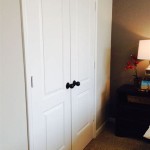36 Inch Interior Door Rough Opening Size: A Comprehensive Guide
The rough opening for an interior door represents the framed opening in a wall where the door and its associated jamb will be installed. Accurately determining the rough opening size is critical for a successful door installation, preventing issues such as the door not fitting correctly, requiring extensive modifications to the framing, or causing operational problems after installation. When dealing with a 36-inch interior door, understanding the nuances of the rough opening dimensions is paramount for achieving a professional and functional result.
A 36-inch door, often measured by the width of the door slab itself, is a standard size commonly used for bedrooms, bathrooms, and other interior spaces where accessibility or wider openings might be beneficial. However, the actual rough opening required is always larger than the specified door width. This difference accounts for the door jamb, shims, and necessary clearances for smooth operation. This article will provide a comprehensive overview of calculating and understanding the rough opening size for a 36-inch interior door, covering essential considerations and best practices.
Understanding the Standard 36-Inch Door Dimensions
The nominal size of a door, such as 36 inches, refers to the width of the door slab itself. However, the actual dimensions of the door slab may be slightly less than the nominal size. This is to allow for proper clearance and functionality within the frame. When planning for a 36-inch interior door, it's crucial to account for the door slab's actual size and the dimensions of the door jamb (the frame surrounding the door).
The standard thickness for an interior door jamb is typically ¾ inch. This thickness is important for determining the overall rough opening size. The jamb provides the structural support for the door and allows for the attachment of hardware such as hinges and strike plates. When the door is closed, the jamb also provides an area for the door to seal against, improving energy efficiency and sound insulation. The jamb itself is comprised of three pieces – two side jambs and a head jamb. These are assembled to create the frame within which the door swings.
The height of a standard interior door is typically 80 inches, although other heights are available. The same principle applies to the height dimension: the rough opening height will need to be greater than the door slab's height to accommodate the jamb and shims. Therefore, both the width and height of the door must be taken into consideration when calculating the rough opening dimensions.
Calculating the Rough Opening Dimensions for a 36-Inch Interior Door
The rough opening calculation involves adding the door slab width, the jamb thickness on both sides, and the necessary clearances for shimming and ensuring proper door operation. Similarly, for the height, the door slab height, the head jamb thickness, and clearances are added. This process is not merely adding a fixed number to the door’s dimensions; it involves understanding the specific components involved.
For the width calculation, consider the following example: a 36-inch door slab, plus a ¾-inch jamb on each side (1.5 inches total), plus ½-inch for shimming and clearance (¼ inch on each side). This results in a rough opening width of 36 inches + 1.5 inches + 0.5 inches = 38 inches. Therefore, the rough opening width should be 38 inches.
For the height calculation, using the same assumptions for clearances, consider the following: an 80-inch door slab, plus a ¾-inch head jamb thickness, plus ½-inch for shimming and floor clearance. This results in a rough opening height of 80 inches + 0.75 inches + 0.5 inches = 81.25 inches. Therefore, the rough opening height should be 81 ¼ inches. This calculation assumes the door is not being installed over carpeting or other thick flooring that might require additional height clearance.
It's crucial to double-check all measurements and to ensure that the rough opening is plumb and square. Any deviation from plumb or square can cause problems with the door installation, leading to difficulties in closing, latching, or maintaining a proper seal. Accurate measurements and a level installation are foundational for a functioning door.
Factors Affecting the Rough Opening Size
Several factors can influence the final rough opening size required for a 36-inch interior door. Understanding these factors allows for more precise calculations and avoids potential installation challenges. These factors can include the type of door jamb, the thickness of shims used, and the presence of flooring that affects the door’s swing.
The style of door jamb can influence the dimensions. Some jambs might be wider or thicker than standard, requiring adjustments to the rough opening. For instance, a split jamb, designed for walls of varying thicknesses, may have slightly different dimensions than a standard jamb. Similarly, pre-hung doors, which come with the door already installed in the jamb, might require a specific rough opening size dictated by the manufacturer.
The thickness of shims used to plumb and align the doorframe within the rough opening also impacts the calculation. If thicker shims are needed to correct for an unlevel or uneven opening, the rough opening might need to be slightly larger to accommodate the additional thickness. Shimming is a critical part of the installation process, ensuring the door is square and operates smoothly. Using excessive shimming, however, can indicate a problem with the framing itself.
The type of flooring installed beneath the door can affect the required height. If carpeting or thick flooring is present, the door needs to clear this flooring when opened and closed. This might require increasing the rough opening height to allow for sufficient clearance. Without adequate clearance, the door may drag on the flooring, causing damage to both the door and the floor. Therefore, it is essential to determine the flooring thickness before finalizing the rough opening height.
Furthermore, it's important to consider any planned trim work that will be installed around the doorframe. While the trim does not directly affect the rough opening size, it can influence the overall aesthetic and the way the door integrates into the surrounding wall. Planning for trim work early on ensures that the door installation complements the room's overall design.
The condition of the existing framing is also an important consideration. If the framing is damaged, warped, or out of square, it may require modifications or repairs before the door can be installed. Addressing any framing issues early on can prevent problems later in the installation process and ensure a long-lasting and functional door.
In summary, a precise understanding of these factors allows for a more accurate rough opening creation. This leads to an easier, more efficient, and ultimately a higher-quality door installation.
Building codes and accessibility requirements also play a role in determining the appropriate rough opening size for an interior door. Local building codes may specify minimum door widths for certain rooms or applications, such as bathrooms or bedrooms. These codes are designed to ensure safety and accessibility for all occupants. It's the responsibility of the homeowner or contractor to confirm these local building codes before beginning any work.
Accessibility guidelines, such as those outlined by the Americans with Disabilities Act (ADA), also dictate minimum clear opening widths for doors in accessible spaces. For example, the ADA typically requires a minimum clear opening width of 32 inches for doorways in accessible routes. While a 36-inch door generally meets this requirement, it's important to ensure that the hardware and door swing do not obstruct the clear opening. Additionally, the approach to the door should be compliant with ADA standards. Therefore, checking current local and federal requirements for compliance is imperative prior to beginning construction or renovation.
Selecting the appropriate rough opening size for a 36-inch interior door involves careful consideration of numerous factors, including the door slab dimensions, jamb type, shimming requirements, flooring thickness, building codes, and accessibility guidelines. By understanding these factors and accurately calculating the necessary dimensions, a homeowner or contractor can ensure a successful and functional door installation.
Accurate measurements are the foundation of a successful door installation. Errors in the rough opening measurements can lead to significant problems, potentially requiring extensive modifications to the framing or resulting in a door that does not operate correctly. Therefore, it is essential to use precise measuring tools and to double-check all measurements before proceeding with the installation.
Professional door installers and carpenters often employ specialized tools, such as laser levels and digital measuring devices, to ensure accuracy. These tools can help to identify any irregularities in the framing and to precisely determine the required rough opening dimensions. While these tools represent an investment, they can save time and prevent costly errors in the long run.

Door Rough Opening Sizes And Charts Ez Hang

Rough Openings For 36 Inch Door Dimensions Installation

Doors Measuring Rough Openings Builders Surplus

Door Rough Opening Sizes And Charts Guide For Interior Exterior Doors Wiki

How To Measure Hollow Metal Door Rough Openings Learn More

Rough Opening For 36 Door Dimensions Installation Guide

How To Measure A Rough Opening For Doors Complete Guide Pros

Rough Opening For Doors 24 28 30 32 36 Sizes Charts

What Size Door Do I Need Guide Charts

How To Measure A Rough Opening For Doors Complete Guide Pros
Related Posts








